SRAM's all-new T-Type Eagle Transmission design mounts directly to the bike's frame coaxially, with the rear wheel losing the derailleur hanger.
As a result of removing the hanger, no b-tension or limit adjustment screws are needed; the distance between the cassette and derailleur is constant.
In doing so, however, SRAM needed to re-think the installation process.
The new process simplifies installation vastly, without the need for measurement tools and chain-length calculations.
Instead, some simple and easy-to-follow steps are required to get T-Type derailleurs performing correctly.
For more about the new T-Type Transmission, read my news story.
If you'd like to find out what it has been like living with T-Type for six months and over 1,000km of riding, check out my in-depth review.
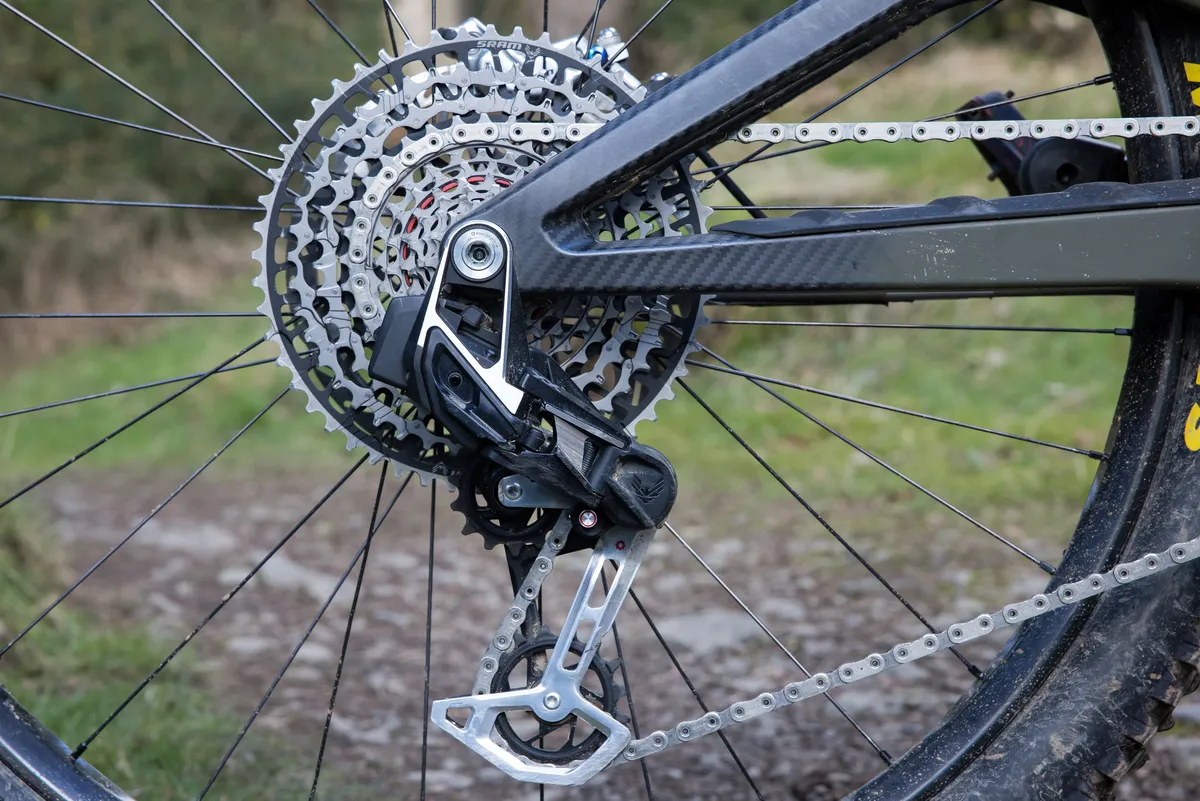
Steps to take before installing your Eagle T-Type Transmission derailleur
- Install the cassette, cranks, chainring and AXS Pod Controller following the instructions on SRAM's website. These are virtually unchanged from SRAM's Eagle drivetrain components
- Fit a charged AXS battery to the derailleur. All SRAM AXS batteries are compatible with T-Type
- Pair the AXS Pod Controller with the rear derailleur by following the instructions on SRAM's website
- Remove your bike's Universal Derailleur Hanger. The UDH's bolt uses a reverse thread, so turn it clockwise to loosen
- Make sure the derailleur's Setup Key is in the correct position for your bike. Consult SRAM's website for more information
- Shift the derailleur to the correct setup gear, according to the instructions on SRAM's website for your bike
Install the Bushing Frame Insert
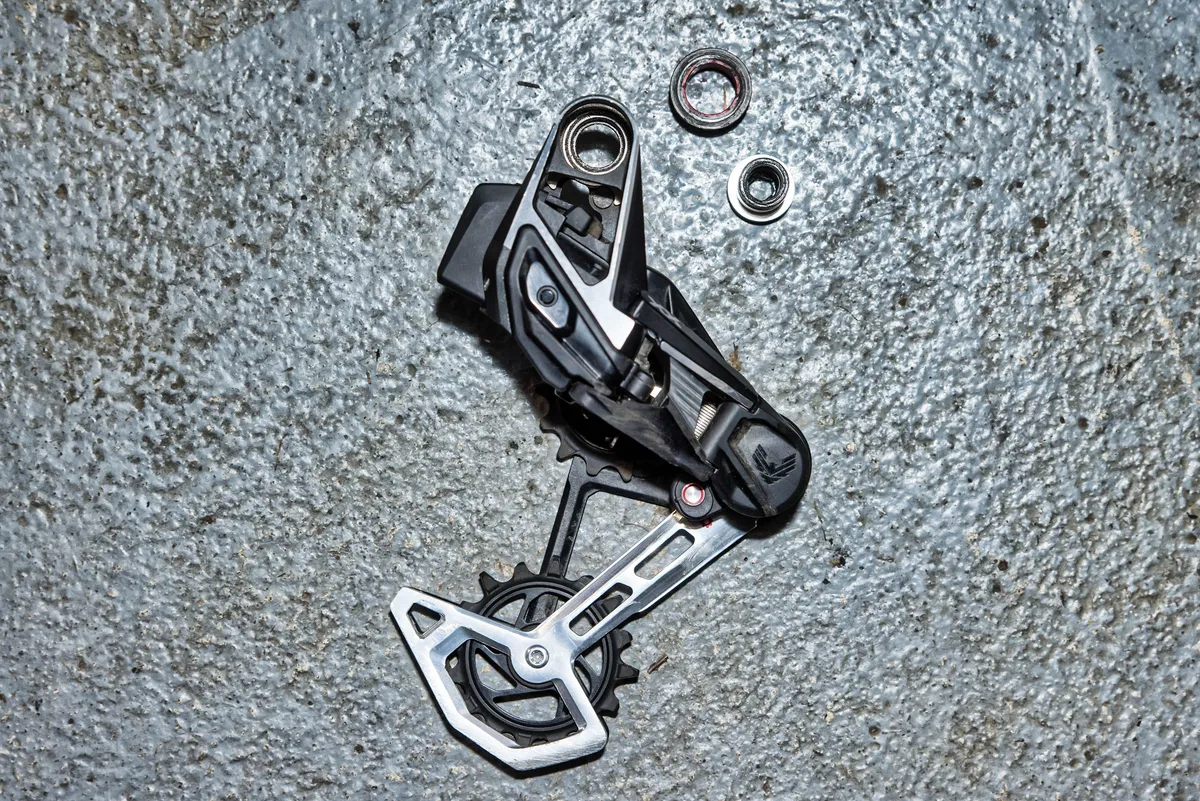
Remove the derailleur's mount bolt and bushing using an 8mm Allen key.
Clean the bike's Hangerless Interface and make sure there is no paint or other debris inside the dropout.
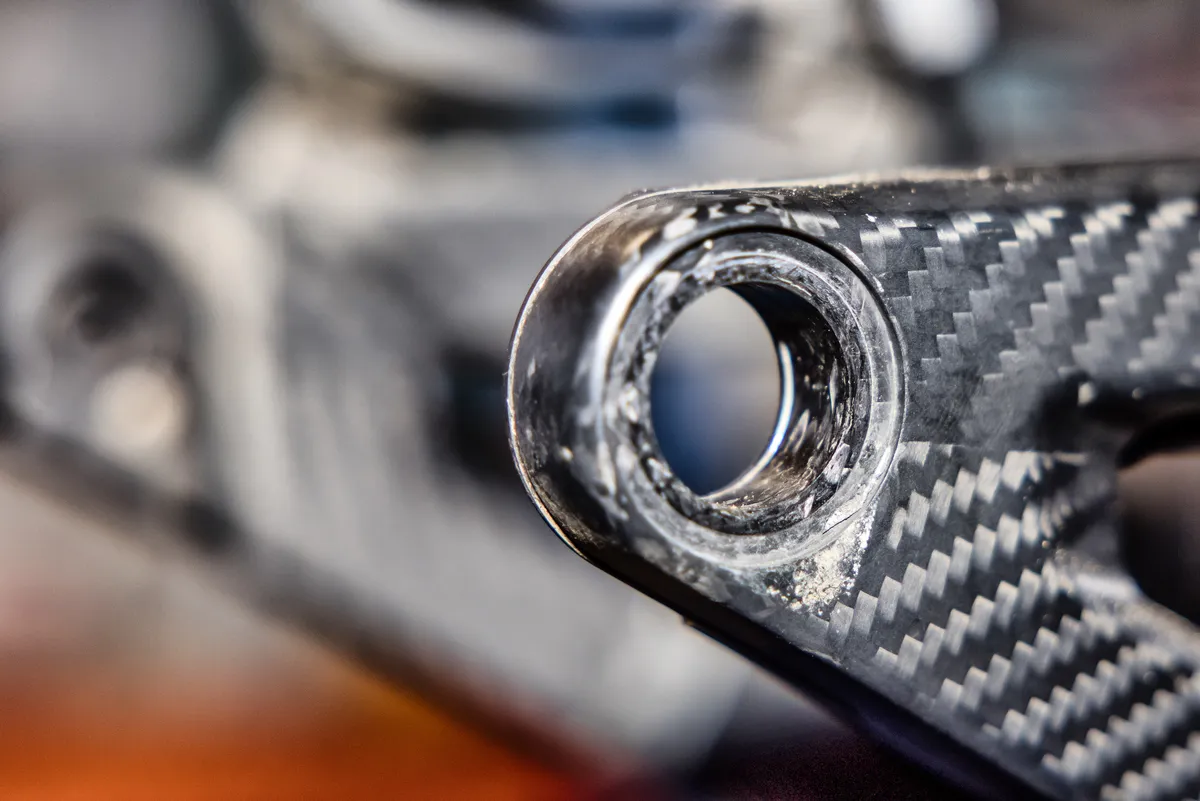
Do not grease the bushing or the Hangerless Interface.

Insert the bushing into the frame's Hangerless Interface from the outside with the lipped edge facing outwards.

Attaching the T-Type Eagle Transmission derailleur
Prior to installation, verify the knurled ring (that's on the inboard portion of the derailleur's Full Mount) is rotated fully clockwise on its stopper. The stopper has to be between the ring's two 'horns'.

Grease the derailleur's mount bolt threads and underside of the bolt's flange.

Slide the derailleur's Full Mount over the bike's Hangerless Interface and Bushing Frame Insert. Then install the derailleur mount bolt from the outside.
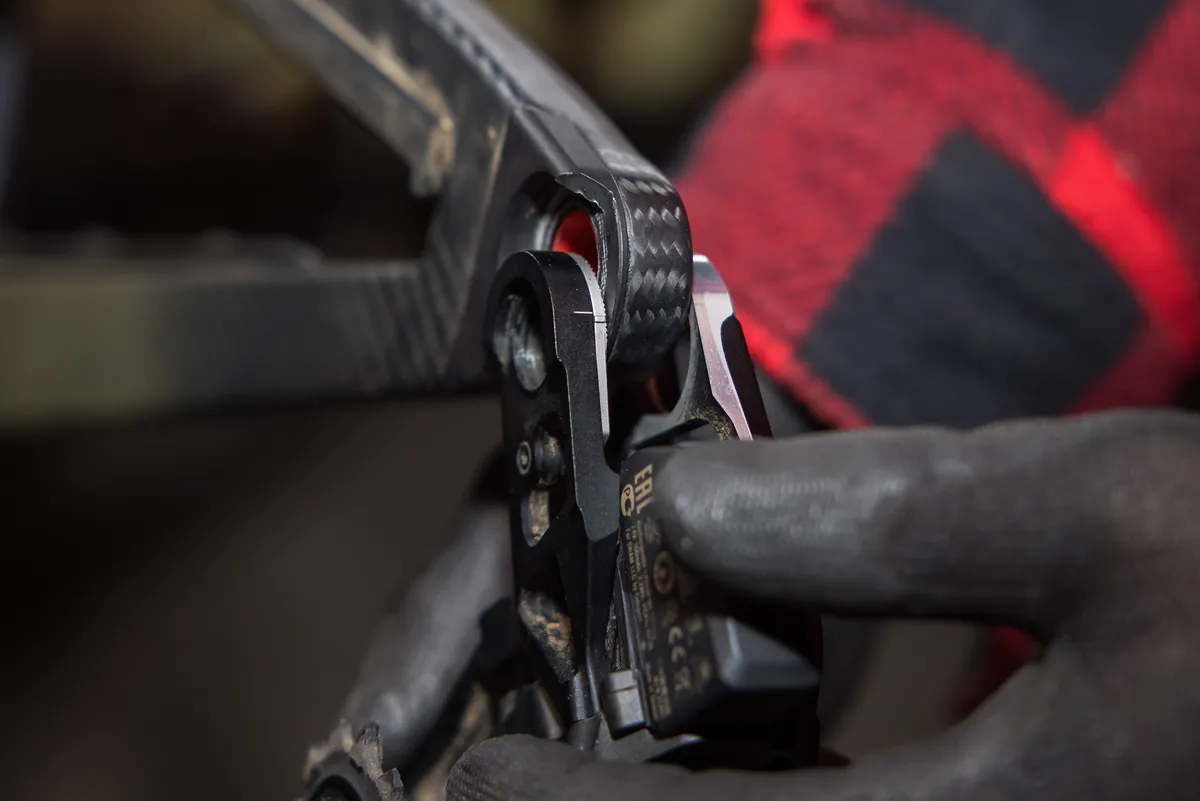
Tighten the bolt using an 8mm Allen key by turning it clockwise until it's snug.
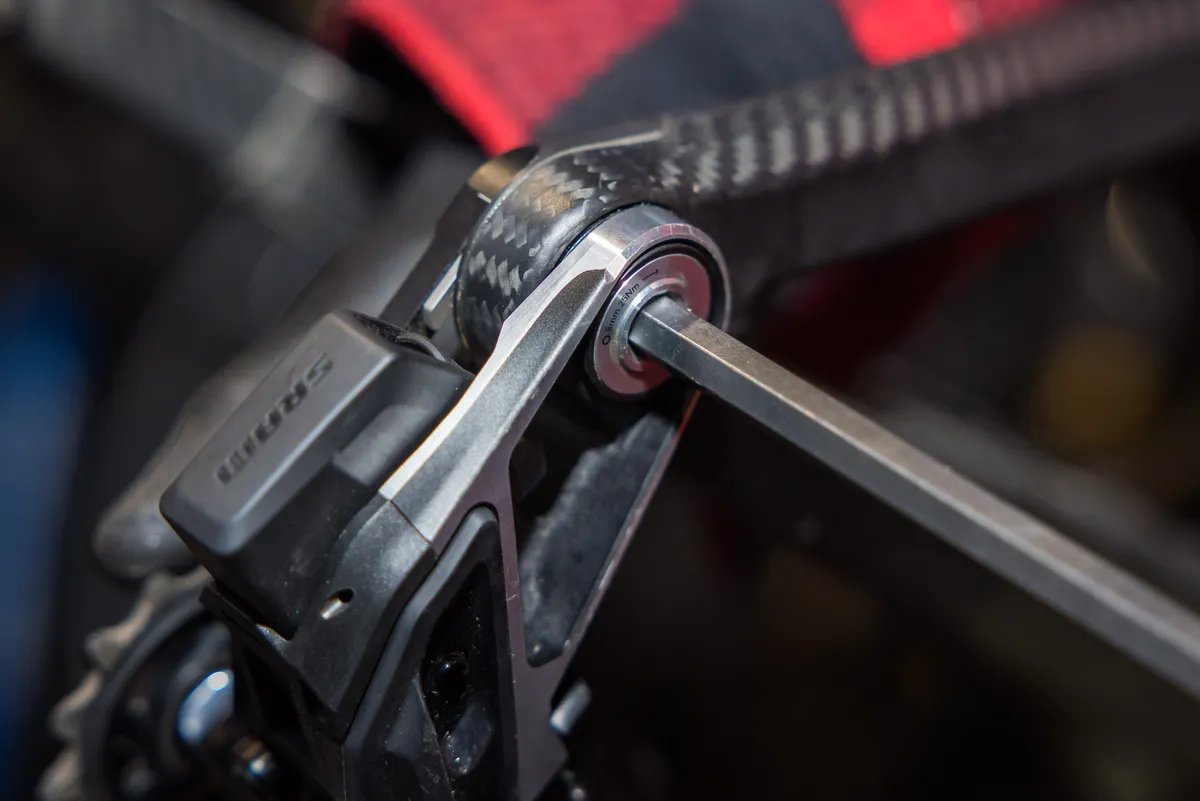
Next, loosen the mount bolt by one full turn counter-clockwise, using an 8mm Allen key.
Set the derailleur to its extended position by pushing the cage forward and locking it in place using the Cage Lock button.

Mounting the rear wheel
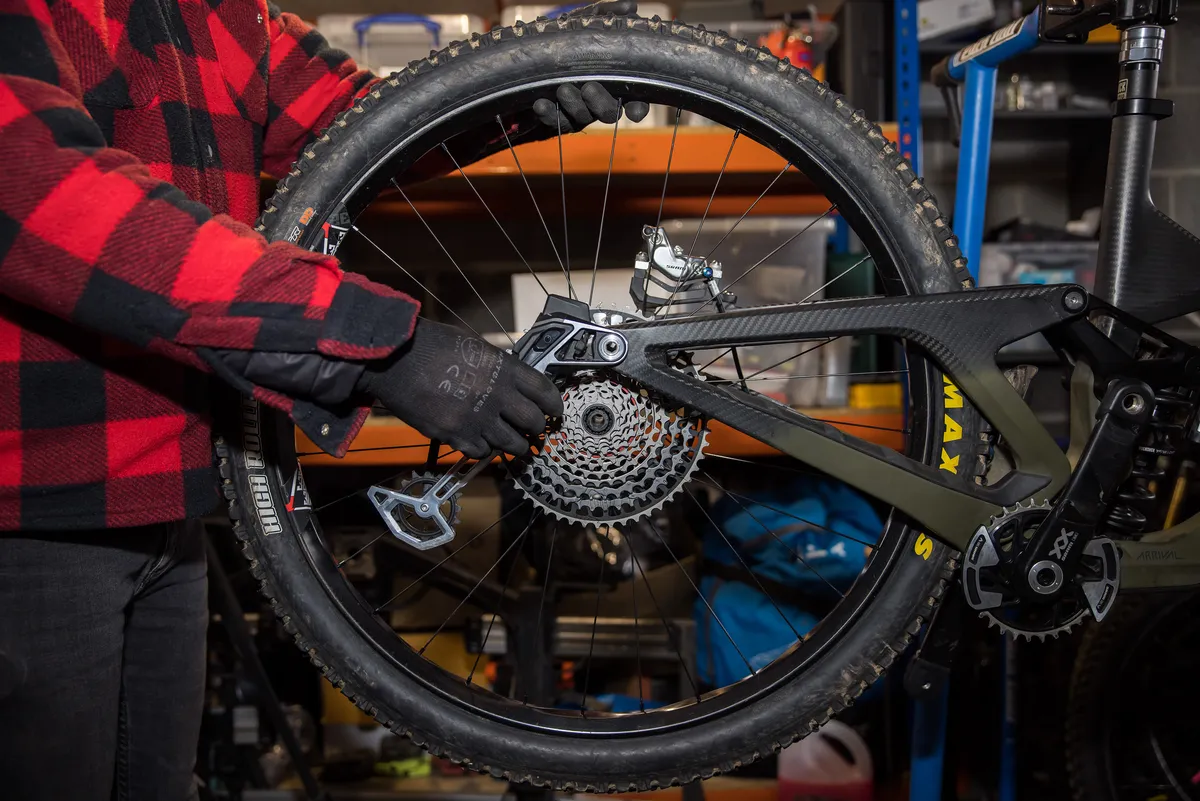
Grease the rear wheel axle threads prior to installation.
Install the rear wheel according to your bike manufacturer's specifications and tighten the axle to snug.
Loosen the rear wheel axle one full turn by turning it counter-clockwise.
Sizing and mounting the T-Type Eagle Transmission chain

Using SRAM's chain length chart, size your chain according to the instructions.
Chainring size and chainstay length will dictate how many links your chain needs.
| Chainstay length (mm) | 30T | 32T | 34T | 36T | 38t | 40T | 42T |
|---|---|---|---|---|---|---|---|
| 425 | 114 | 114 | 116 | 116 | 118 | 118 | 120 |
| 426 | 114 | 114 | 116 | 116 | 118 | 118 | 120 |
| 427 | 114 | 114 | 116 | 116 | 118 | 118 | 120 |
| 428 | 114 | 116 | 116 | 118 | 118 | 120 | 120 |
| 429 | 114 | 116 | 116 | 118 | 118 | 120 | 120 |
| 430 | 114 | 116 | 116 | 118 | 118 | 120 | 120 |
| 431 | 114 | 116 | 116 | 118 | 118 | 120 | 120 |
| 432 | 114 | 116 | 116 | 118 | 118 | 120 | 120 |
| 433 | 114 | 116 | 116 | 118 | 118 | 120 | 120 |
| 434 | 116 | 116 | 118 | 118 | 120 | 120 | 122 |
| 435 | 116 | 116 | 118 | 118 | 120 | 120 | 122 |
| 436 | 116 | 116 | 118 | 118 | 120 | 120 | 122 |
| 437 | 116 | 116 | 118 | 118 | 120 | 120 | 122 |
| 438 | 116 | 116 | 118 | 118 | 120 | 120 | 122 |
| 439 | 116 | 116 | 118 | 118 | 120 | 120 | 122 |
| 440 | 116 | 116 | 118 | 118 | 120 | 120 | 122 |
| 441 | 116 | 118 | 118 | 120 | 120 | 122 | 122 |
| 442 | 116 | 118 | 118 | 120 | 120 | 122 | 122 |
| 443 | 116 | 118 | 118 | 120 | 120 | 122 | 122 |
| 444 | 116 | 118 | 118 | 120 | 120 | 122 | 122 |
| 445 | 116 | 118 | 118 | 120 | 120 | 122 | 122 |
| 446 | 116 | 118 | 118 | 120 | 120 | 122 | 122 |
| 447 | 118 | 118 | 120 | 120 | 122 | 122 | 124 |
| 448 | 118 | 118 | 120 | 120 | 122 | 122 | 124 |
| 449 | 118 | 118 | 120 | 120 | 122 | 122 | 124 |
| 450 | 118 | 118 | 120 | 120 | 122 | 122 | 124 |
| 451 | 118 | 118 | 120 | 120 | 122 | 122 | 124 |
| 452 | 118 | 118 | 120 | 120 | 122 | 122 | 124 |
| 453 | 118 | 118 | 120 | 120 | 122 | 122 | 124 |
| 454 | 118 | 120 | 120 | 122 | 122 | 124 | 124 |
| 455 | 118 | 120 | 120 | 122 | 122 | 124 | 124 |
| 456 | 118 | 120 | 120 | 122 | 122 | 124 | 124 |
| 457 | 118 | 120 | 120 | 122 | 122 | 124 | 124 |
| 458 | 118 | 120 | 120 | 122 | 122 | 124 | 124 |
| 459 | 118 | 120 | 120 | 122 | 122 | 124 | 124 |
| 460 | 120 | 120 | 122 | 122 | 124 | 124 | 126 |
| 461 | 120 | 120 | 122 | 122 | 124 | 124 | 126 |
| 462 | 120 | 120 | 122 | 122 | 124 | 124 | 126 |
| 463 | 120 | 120 | 122 | 122 | 124 | 124 | 126 |
| 464 | 120 | 120 | 122 | 122 | 124 | 124 | 126 |
| 465 | 120 | 120 | 122 | 122 | 124 | 124 | 126 |
| 466 | 120 | 122 | 122 | 124 | 124 | 126 | 126 |
| 467 | 120 | 122 | 122 | 124 | 124 | 126 | 126 |
| 468 | 120 | 122 | 122 | 124 | 124 | 126 | 126 |
| 469 | 120 | 122 | 122 | 124 | 124 | 126 | 126 |
| 470 | 120 | 122 | 122 | 124 | 124 | 126 | 126 |
Brand new T-Type chains have 126 links, so count backwards along the chain to the number of links you need.
Chain lengths are specified in even numbers and you need cut the chain with an 'open' end so the PowerLock can be installed later.
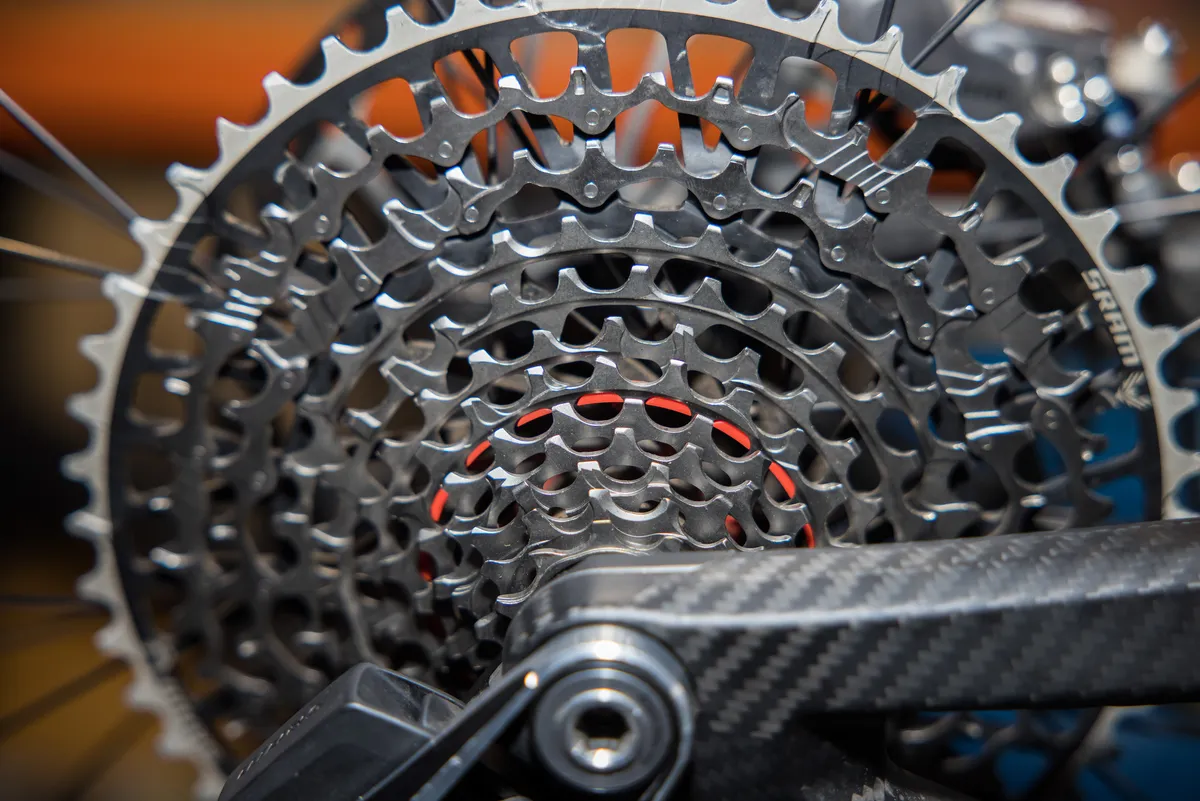
Place the correctly sized T-Type chain with its flat section facing away from the centre of the cassette on the cassette's setup cog, denoted by the red ring.
Some bikes need to use a different gear for setup. Consult SRAM's website to check which setup cog is needed for your bike.

Pull each end of the chain together beneath the bike's chainstay.

Install the PowerLock with the flat portion orientated in the same direction as the chain.

Move the T-Type Transmission derailleur to the Setup position
Push the derailleur cage forward to release the Cage Mode button carefully.

Reposition the cage so the Cage Mode button locks into the Cage Setup position.
Rotate the pedal cranks forward until the PowerLock is above the centre of the chainstay.

Double check the two halves of the PowerLock are installed and engaged correctly.

Use chain link pliers to lock the PowerLock, or apply the rear brake and push down on the pedal cranks.
The PowerLock should click into place.
Tightening the T-Type Transmission derailleur and rear wheel axle
Prior to continuing, check the following:
- The rear axle and derailleur mount bolt are loosened from snug by one full turn
- The derailleur is in the correct Setup Key and Setup Mode for your bike
- The chain is on the correct Setup Cog for your bike and is engaged correctly on the cassette and chainring
- The PowerLock is closed; on full-suspension bikes, rear suspension is uncompressed with no sag, unless instructed otherwise on SRAM's website.
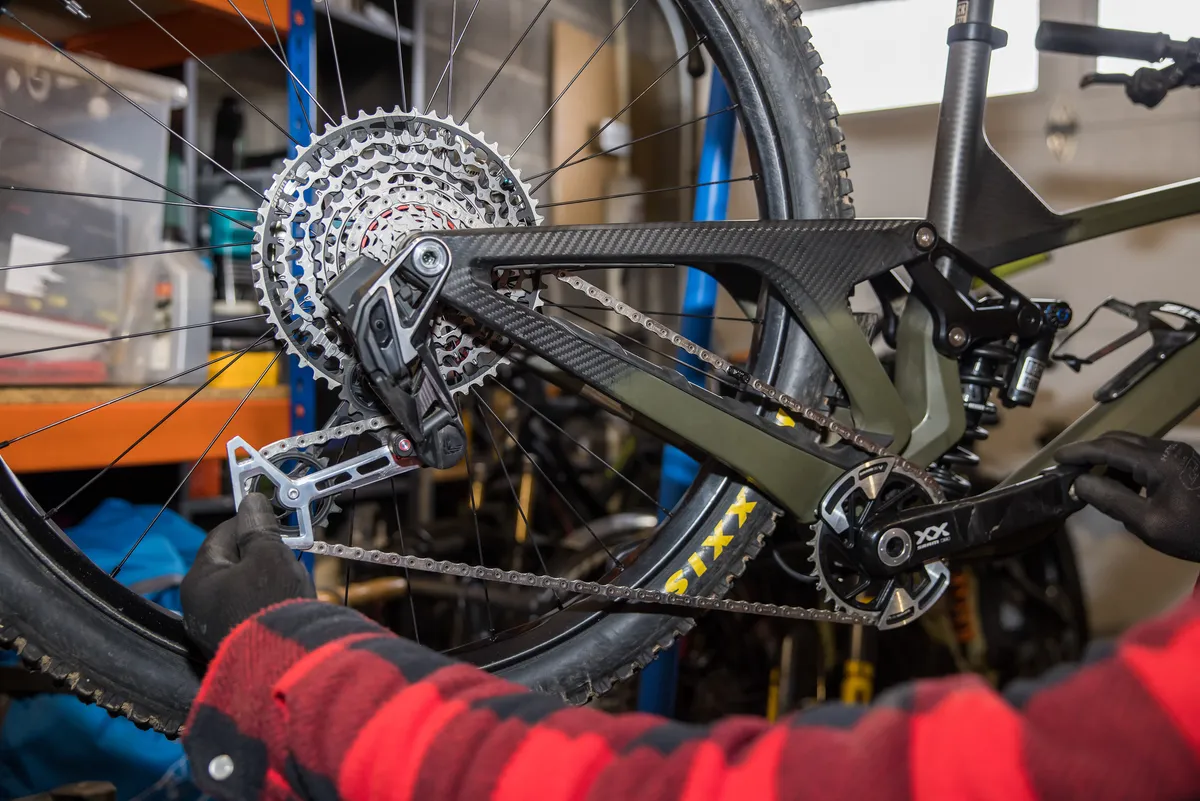
Pull back on the lower portion of the derailleur's cage until the chain is tight.
Continue to pull back while rotating the crank forward two rotations to confirm the chain stays in the Setup Cog.

While continuing to pull back on the derailleur's cage to keep the chain taut, tighten the derailleur mount to 35Nm with an 8mm Allen key.
If there is slack in the chain once you've tightened the derailleur, loosen it and perform this step again.
Make sure the knurled ring mark aligns with the mark on the derailleur's Full Mount.

If it does not align, loosen the rear wheel axle and derailleur mount bolt and rotate it clockwise so it's touching the knurled ring stop.
If you need to do this, repeat the above derailleur mount bolt tightening steps.

Tighten the rear wheel axle to the manufacturer-supplied torque.
Release the derailleur cage from Setup Mode to Ride Mode by rotating it forwards, then carefully letting it return to its unlocked position.
Final checks prior to riding

In a bike stand, rotate the cranks forward, shifting slowly through each of the gears.
To fine-tune gears, either use SRAM's AXS smartphone app or press the AXS button and upper or lower shifter button simultaneously to MicroAdjust the derailleur inboard or outboard.
Your SRAM T-Type Eagle Transmission is now installed and ready to ride!
